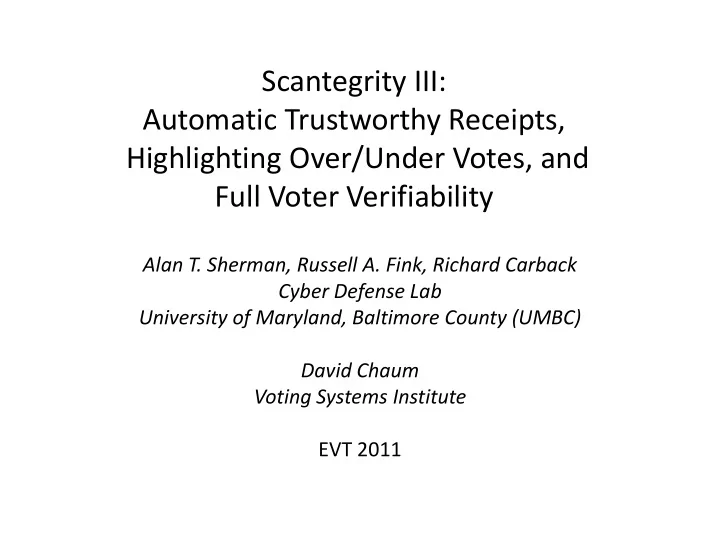

Scantegrity III: Automatic Trustworthy Receipts, Highlighting Over/Under Votes, and Full Voter Verifiability Alan T. Sherman, Russell A. Fink, Richard Carback Cyber Defense Lab University of Maryland, Baltimore County (UMBC) David Chaum Voting Systems Institute EVT 2011
Contributions: Improvements to Scantegrity II • Three designs for trustworthy receipt printers • Eliminate need for separate print audit • New user interface for optical scan: achieve HAVA compliance with backlighting of over/under votes • Design enhancements with TPM • Improved security: – Encourage more voters to verify on-line – Detect marks added to ballot after casting – Make copies of all receipts public
Outline • Scantegrity II end-to-end voter-verifiable elections • Issues from 2009 Takoma Park municipal election • Related work • Three designs – Simple image duplicator (separate from scanner) – Mark sense translator (connected to scanner) – Scantegrity III (embellished mark sense translator protective back-lighted glass) • Discussion
Scantegrity II www.scantegrity.org
2009: Takoma Park, Maryland, Elects Mayor with Scantegrity David Chaum Inventor, Scantegrity
Issues from Takoma Park 2009 • Many voters did not write down codenumbers – Some voters found it difficult to read the codenumbers and write them down – Some voters did not known they needed to write down codenumbers to verify on-line • Scanner was not HAVA compliant • Print audit added cost and complexity We address these issues
Related Work • Sure Vote (Chaum, 2004) • Vote Here (Neff, 2004) • Punchscan (Chaum et al., 2006) • Sigma Ballot (Popoveniuc, 2010) This paper refines and integrates: • Image duplicator / mark sense translator (Fink & Carback, 2010) • Scantegrity III (Chaum, 2011)
Image Duplicator • Separate optional station • Copies bubble contents • For each race, orders bubbles by decreasing pixel intensity • Stateless design • Reads on-line verification number and markable positions from 2D barcode (and senses alignment marks)
Image Duplicator
Mark-Sense Translator • Connected to PCOS scanner, which detects marked positions • Stateful design: prints codes from marked positions and privileged information • Reads encrypted codes from 2D barcode (key bound to TPM) • Ballot locked under glass while voter checks receipt
Mark-Sense Translator
Scantegrity III Casting Station • Embellished mark sense translator • New ballot format • Two different receipt types (type chosen in a verifiably random way) • Eliminates need for print audits • Highlights over/under votes (and more) with LED backlighting
Scantegrity III Ballot and Receipts a
Verifiable Randomness • Random • Unpredictable • Voter can verify that proper procedure was followed (but voter doesn’t influence) • Bits become part of public audit record • Ex: Camera observes roll of red/green die in clear dome
Eliminating Print Audits • In Scantegrity II, print audit is destructive: audited ballot cannot be cast • In Scantegrity III, indirection permits auditing of cast ballots – Receipt type I catches misprinting of S1 codes (after release of race S1 commitment) – Receipt type II catches misprinting of S2 codes (after release of S1 S2 commitment)
Scantegrity III Ballot and Receipts a
Bolstering Designs with TPM • End-to-End integrity is not End-to-End security • Protect privacy, enforce election policy, detect problems sooner • TPMs help ensure correct software is booted, provide place to store keys & codes, offer monotonic counters • Election integrity does not depend on TPM
Discussion • Image duplicator – Simple, stateless, low marginal risk – Separate station; no guarantee same ballot is cast • Mark sense translator – More complex mechanism, TPM learns codes • Scantegrity III casting station – Eliminates print audit; backlights ballot – More complex ballot and checking at station
Security Advantages • More voters will likely verify votes on-line if receipts are easier to produce • Copies of all receipts could be made publicly available • Improves usability and accessibility • Can detect if extra marks are added after scanning (for stateful designs) • Failsafe mode of operation is Scantegrity II
Potential Threats: Malicious Receipt Printers • Leak codes – Privacy loss; facilitates bogus claims of malfeasance • Produce invalid signatures; authenticate false receipt; malfunction – Disruption; discreditation Similar to threats from malicious scanners. Cannot violate integrity without detection: voter can compare receipt with ballot; voter can still make hand-written receipt.
Eliminating Invisible Ink • With mark sense translator, could “late - bind” codes by printing codes for first time on receipt (requires trust in TPM) • Reduces complexity caused by invisible ink • Failsafe mode of operation becomes Scantegrity I, if technology fails • Improves accessibility ( e.g., blind voters can hear codes)
Open Problems • Implement and test • How well will human voters respond to designs? • Improve accessibility
Conclusion • Improvements to Scantegrity: – Print trustworthy receipts automatically – Eliminate print audit – New back-lighted interface for opscan • Three receipt printer designs – Simple stateless image duplicator introduces fewest potential additional security vulnerabilities – Which is best depends on situation
Acknowledgments • Sherman was supported by DoD IASP grants H98230-09-1-0404 and H98230-10-1-0359.
Questions? 25
Recommend
More recommend